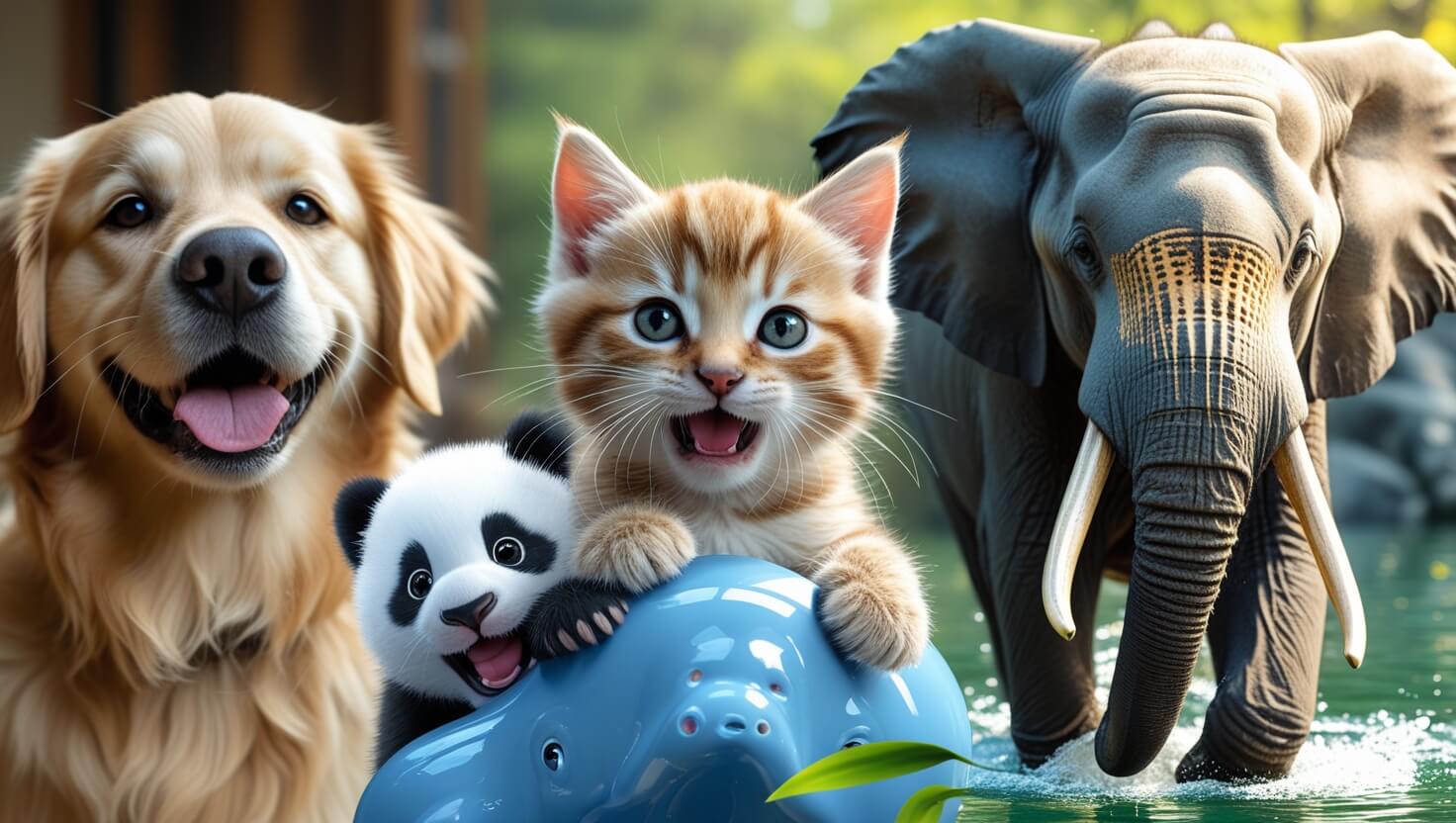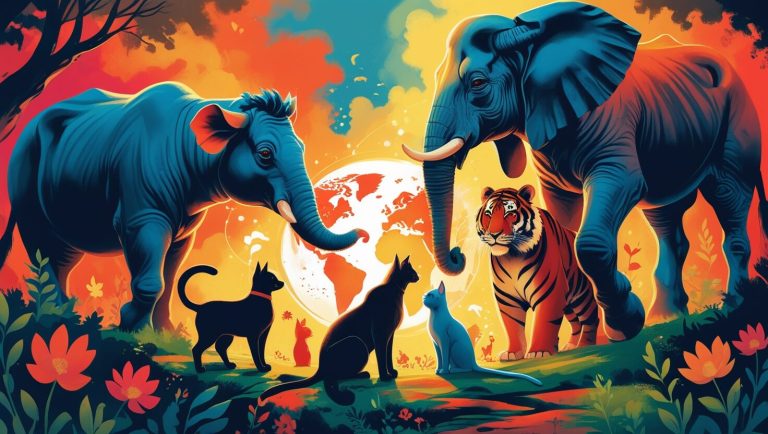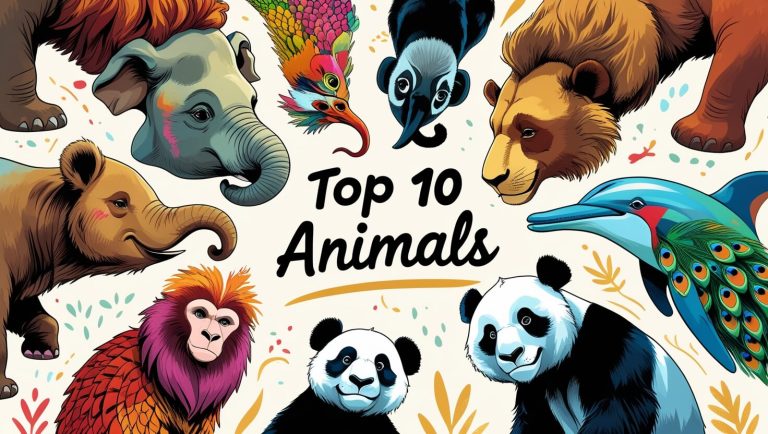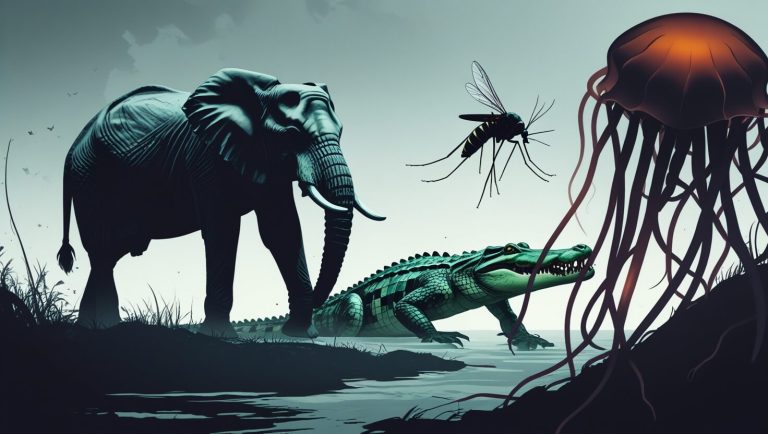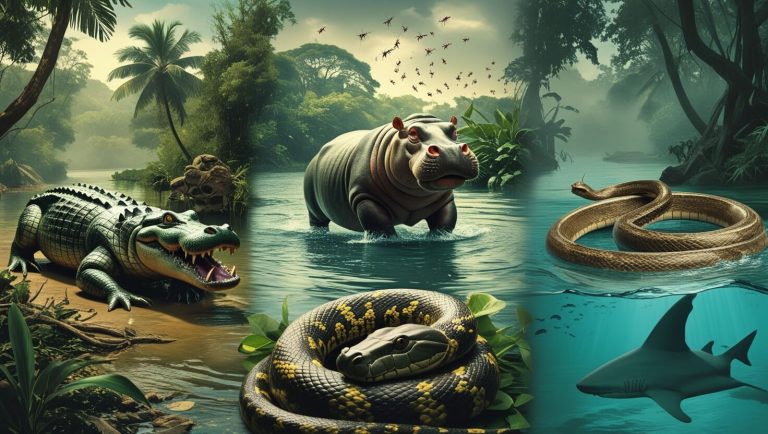Top 10 Most Loved Animals : Why We Adore Them
Did you know that over 60% of global households have pets, with dogs and cats being the most popular companions? This isn’t just a coincidence; it’s a testament to the powerful, often indescribable bond we share with the animal kingdom.
From the loyal wag of a dog’s tail to the majestic sight of an elephant in the wild, animals hold a special, cherished place in our hearts. They provide us with companionship, comfort, and an endless source of wonder. They fill our social media feeds, star in our favorite movies, and stand as powerful symbols in our cultures and histories.
This blog post is a journey to explore the top 10 most beloved animals around the world and to uncover the reasons behind our collective affection. Our ranking is based on a blend of several factors: their popularity as pets and in the wild, the emotional connection they forge with us, their unique appearance and personality, and their undeniable presence in pop culture. This is more than just a list; it’s a celebration of the animals that have taught us about loyalty, courage, and the simple joy of companionship.
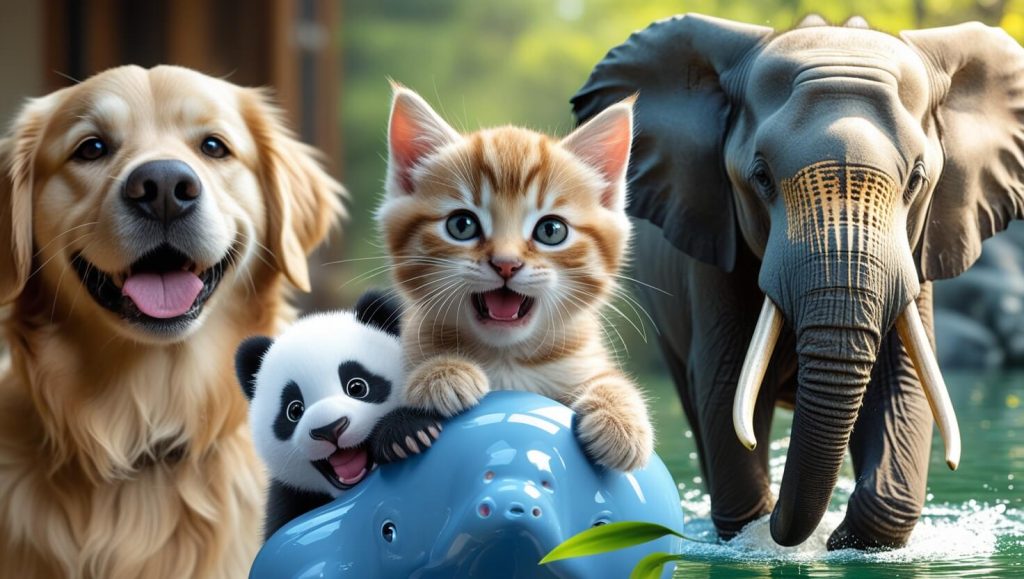
What Makes an Animal ‘Loved’?
The love we feel for animals is a complex tapestry woven from emotional, psychological, and cultural threads. For many, it starts with an emotional bond—the unconditional love a pet provides, which can soothe loneliness and anxiety. This connection is scientifically proven; studies have shown that interacting with animals can lower cortisol levels, the body’s primary stress hormone, and increase oxytocin, the “love hormone.”
Beyond our personal lives, our affection is heavily influenced by the media we consume. Wildlife documentaries take us to the farthest corners of the globe, allowing us to witness the complex social structures of elephants or the heroic migrations of penguins. Social media platforms are a constant stream of viral animal videos, turning ordinary house pets into global superstars and raising awareness for endangered species.
Furthermore, animals carry deep cultural and symbolic significance. The horse, once a tool of war and agriculture, now represents grace and freedom. The dolphin, revered in ancient myths, symbolizes intelligence and harmony with nature. Our love for these animals is a reflection of the qualities we admire and aspire to—loyalty, strength, and resilience.
Top 10 Most Loved Animals
Here are the animals that have truly captured the world’s heart, each with their own unique story and charm.
1. Dogs
Often called “man’s best friend,” the dog’s journey with humanity began over 30,000 years ago, evolving from wolves into the diverse and loyal companions we know today. A fun fact: A dog’s sense of smell is up to 100,000 times more acute than a human’s.
Why it’s loved: Dogs are the undisputed champions of loyalty and unconditional love. They greet us with a wagging tail, comfort us when we’re down, and stand by our side through thick and thin. Their protective nature and eagerness to please make them feel like a true part of the family.
Personality Traits: Dogs are incredibly diverse, but their common traits include playfulness, intelligence, and a deep-seated desire for social connection. They are intuitive and often seem to understand our moods, offering a nudge or a lick precisely when we need it most.
Famous Appearances: The silver screen is filled with beloved dogs. From the heroic Lassie to the ever-faithful Hachiko, whose story of waiting for his owner long after his death became a global sensation, dogs have always been a staple in emotional storytelling. On a lighter note, Scooby-Doo and Snoopy have charmed generations with their antics.
Cultural Roles: Dogs serve in crucial roles as service animals, police dogs, and search-and-rescue partners. They are the most popular pet globally and a symbol of companionship and devotion in nearly every culture.
2. Cats
Revered as deities in ancient Egypt, cats have a long and storied history of captivating humans with their grace and independence. A fun fact: A cat’s purr is not just a sign of happiness; it can also be a self-healing mechanism, with vibrations that can help repair bones and tissues.
Why it’s loved: Cats offer a unique blend of independence and affection. They might not always be as outwardly expressive as dogs, but their head-butts, slow blinks, and quiet purrs are powerful signs of trust and love. They are calming companions who bring a sense of tranquility to our homes.
Personality Traits: Cats are famously curious, clean, and often have a mysterious charm. While some are lap-sitters, others are content to simply be in the same room, providing a comforting presence without demanding constant attention.
Famous Appearances: The internet wouldn’t be the same without viral cat videos and memes, from the iconic Grumpy Cat to the whimsical Nyan Cat. In pop culture, Garfield’s laziness and Tom’s endless pursuit of Jerry have made cats household names.
Cultural Roles: Cats are popular pets worldwide and have long been associated with good luck and magic in various cultures. Their independence is often admired, and their status as internet celebrities has solidified their place in modern society.
3. Dolphins
Known as the most intelligent creatures in the ocean, dolphins are highly social mammals that have been fascinating scientists for decades. A fun fact: Dolphins are not fish; they are warm-blooded mammals that breathe air and even sleep with half their brain at a time, allowing them to stay alert for predators.
Why it’s loved: Their playful nature and friendly interactions with humans make dolphins a global favorite. Seeing them leap from the water or surf alongside a boat is an exhilarating experience that connects us to the wild beauty of the ocean.
Personality Traits: Dolphins are incredibly intelligent, cooperative, and communicative. They live in complex social groups called pods and are known for their intricate vocalizations, including clicks, whistles, and squeals, which they use to communicate and navigate.
Famous Appearances: The television show Flipper made dolphins a household name, showcasing their intelligence and loyalty. They are central to countless wildlife documentaries, which highlight their remarkable behaviors and emotional depth.
Cultural Roles: Dolphins have been revered in myths and folklore for centuries, often symbolizing grace, joy, and wisdom. Their intelligence has made them a focal point for marine conservation and research.
4. Horses
For thousands of years, the horse was one of humanity’s most important partners, shaping our history and civilization. A fun fact: A horse’s eyes are larger than those of any other land mammal, giving them a remarkable field of vision.
Why it’s loved: Horses are admired for their grace, power, and loyalty. The emotional connection a rider can form with a horse is profound, based on trust, communication, and mutual respect. They are noble creatures that inspire awe and a sense of freedom.
Personality Traits: Horses are intuitive, gentle, and have a unique ability to sense human emotions. They can be trained to perform complex tasks and form strong, lasting bonds with their human handlers.
Famous Appearances: From the emotional journey of Black Beauty to the animated spirit of freedom in Spirit: Stallion of the Cimarron, horses have always been powerful figures in movies and novels. The fantasy world of My Little Pony has made them beloved by a younger audience.
Cultural Roles: Horses were crucial in human history for transportation, warfare, and agriculture. Today, they are a powerful symbol of freedom, strength, and nobility, and they are still celebrated in sports and competitive riding.
5. Pandas
The giant panda is a bear native to south-central China and is perhaps the most famous symbol of conservation in the world. A fun fact: A newborn panda cub is tiny, weighing only about 100 grams, and is completely blind and helpless.
Why it’s loved: Pandas are adored for their cute, cuddly appearance and their gentle, seemingly placid demeanor. Their black-and-white markings and round faces give them an irresistible charm that makes them instantly recognizable and beloved globally.
Personality Traits: Pandas are solitary and peaceful, spending most of their time eating bamboo. Their slow-paced, non-threatening nature is part of their appeal.
Famous Appearances: Po from Kung Fu Panda has made the giant panda a pop culture icon, showcasing a lovable underdog’s journey to becoming a hero. The panda is also the logo of the World Wildlife Fund (WWF), making it a universal symbol for endangered species.
Cultural Roles: Pandas are central to “Panda Diplomacy,” where China lends pandas to other countries as a sign of goodwill. They are a powerful reminder of the importance of protecting our planet’s biodiversity.
6. Elephants
As the largest land mammals on Earth, elephants are known for their incredible size and long memories. A fun fact: The elephant’s trunk is an incredibly versatile tool, containing over 40,000 muscles and capable of lifting heavy objects or picking up a single blade of grass.
Elephants are admired for their intelligence, emotional depth, and strong family bonds. They live in matriarchal societies and are known for their empathetic nature, often showing signs of compassion for injured or dying herd members.
Personality Traits: Elephants are highly intelligent, with a long memory. They are protective of their young and have complex social rituals, including mourning their dead.
Famous Appearances: The animated film Dumbo tugged at our heartstrings with its story of a young elephant with oversized ears, and The Jungle Book‘s Colonel Hathi showcased their noble, military-like demeanor.
Cultural Roles: In many cultures, particularly in Asia, elephants are revered as symbols of wisdom, strength, and royalty. In Hinduism, the elephant-headed god Ganesha is worshipped as a remover of obstacles.
7. Penguins
Penguins are a group of flightless birds that have adapted to life in the Southern Hemisphere. A fun fact: They are not black and white just for looks; their coloring is a form of camouflage, with the white belly hiding them from predators below and the black back blending with the dark ocean from above.
Why it’s loved: Penguins’ quirky waddling, “tuxedo” appearance, and family-oriented behavior make them incredibly endearing. We are captivated by their monogamous relationships and their dedication to raising their young in some of the world’s harshest environments.
Personality Traits: Penguins are social birds that live in large colonies. They are known for their resilience, monogamy, and the comical way they move on land.
Famous Appearances: The animated movie Happy Feet brought the joy of penguins to a global audience, while the documentary March of the Penguins captivated viewers with the true-life story of their epic journey to breed.
Cultural Roles: Penguins have become symbols of perseverance, teamwork, and family devotion. Their unique biology and behavior continue to be a source of fascination and a key focus of climate change documentaries.
8. Rabbits
Known for their long ears and twitching noses, rabbits have been popular companions for centuries. A fun fact: A rabbit’s teeth never stop growing, which is why they constantly need to chew on things to wear them down.
Why it’s loved: Rabbits are soft, gentle, and adorable. Their quiet nature and small size make them popular pets, especially for families. They are a symbol of softness and innocence.
Personality Traits: Rabbits are playful, social, and intelligent. They can be litter-trained and can form strong bonds with their owners, often showing affection with gentle nudges and purrs.
Famous Appearances: The iconic Bugs Bunny has made rabbits a symbol of cleverness and humor, while Peter Rabbit and the Easter Bunny have cemented their place in children’s literature and festive traditions.
Cultural Roles: Rabbits are symbols of fertility, new beginnings, and good luck in many cultures. The “rabbit’s foot” is a well-known good luck charm, and the Easter Bunny is a beloved figure worldwide.
9. Tigers
Tigers are the largest of the big cats and are known for their magnificent striped coats. A fun fact: No two tigers have the same stripes; their patterns are as unique as human fingerprints.
Why it’s loved: Tigers are admired for their majestic beauty, immense power, and mysterious aura. They are solitary and powerful predators, yet their grace and dignity have made them a beloved figure in human culture.
Personality Traits: Tigers are solitary and territorial, but they are also known for their stealth and intelligence as hunters.
Famous Appearances: The ferocious yet dignified Shere Khan from The Jungle Book and the lovable, bouncy Tigger from Winnie the Pooh showcase the two sides of the tiger’s personality in fiction.
Cultural Roles: The tiger is the national animal of several countries, including India and Bangladesh, and is a symbol of strength and power. It also serves as a powerful mascot for sports teams and is a key icon for global conservation efforts.
10. Parrots
Found in tropical and subtropical regions, parrots are known for their vibrant colors and intelligence. A fun fact: The kakapo, a species of parrot from New Zealand, is the world’s only flightless parrot.
Why it’s loved: Parrots are loved for their vibrant plumage, their ability to mimic human speech, and their long lifespans, which can make them lifelong companions. Their intelligence and quirky personalities make them fascinating pets.
Personality Traits: Parrots are highly intelligent, social, and curious birds. They are known to be playful and can be trained to perform tricks and mimic sounds and phrases.
Famous Appearances: Iago from Disney’s Aladdin and the movie Paulie have made parrots famous on screen, showcasing their intelligence and ability to talk. Many viral videos on social media feature parrots having conversations or singing songs.
Cultural Roles: Parrots are symbols of tropical beauty, communication, and companionship. Their ability to speak has long fascinated humans, making them a fixture in stories and fables.
Honorable Mentions
While the top 10 have captured our hearts, several other animals deserve a special mention for their unique charm. Koalas are loved for their sleepy, gentle nature and their adorable, teddy-bear-like appearance. Owls fascinate us with their silent flight and large, piercing eyes, symbolizing wisdom and mystique. Monkeys are a constant source of entertainment with their human-like antics and playful intelligence. Turtles are admired for their longevity and resilience, representing patience and wisdom. Finally, Guinea Pigs are cherished as gentle, social, and adorable small pets.
How Pop Culture Influences Our Love for Animals
In today’s interconnected world, pop culture is a powerful driver of our affection for animals. Social media platforms, in particular, have turned animals into global sensations. Viral videos of cats performing funny stunts, dogs showing off their tricks, or even a baby panda sneezing have the power to bring a smile to millions of faces. These digital moments create an emotional connection that transcends physical proximity.
Beyond social media, animals have long been a staple in film, books, and branding. The emotional journeys of animals in films like A Dog’s Purpose or documentaries like My Octopus Teacher deepen our empathy for them. Fictional characters like Simba from The Lion King and Hedwig from Harry Potter have made us fall in love with species we might never encounter in real life. These portrayals shape our perceptions and often spark a desire to learn more or even get involved in conservation.
The Role of Loved Animals in Mental Health
The bond we share with animals is not just heartwarming; it’s therapeutic. Pet therapy has become a recognized and effective form of treatment for a range of mental health issues. The simple act of petting a dog or a cat can lower blood pressure and reduce feelings of loneliness and anxiety. Emotional support animals provide constant comfort and a sense of purpose for individuals dealing with conditions like PTSD and depression.
Scientific studies consistently show that animal companionship can significantly improve a person’s overall well-being. Having a pet encourages a routine, which can be beneficial for mental stability, and forces us to be more active. The responsibility of caring for another living being provides a sense of meaning and can boost feelings of self-worth. In essence, the love we give to our animals is returned tenfold in the form of happiness, calm, and a healthier mindset.
Conservation and Responsibility
Our love for animals, especially the wild ones, comes with a crucial responsibility. Many of the most beloved creatures on this list, from tigers and elephants to pandas and dolphins, are facing threats from habitat loss, climate change, and poaching. Our affection should not just be a passive admiration; it must be a catalyst for action.
Our collective love for these animals should translate into a global effort to protect them. This means supporting conservation organizations like the World Wildlife Fund (WWF), the International Fund for Animal Welfare (IFAW), and countless others. It means making conscious choices in our daily lives, such as reducing our carbon footprint and being mindful of how our consumer habits impact the natural world. Readers can get involved by donating, volunteering, or simply spreading awareness about the plight of these magnificent creatures.
FAQs Section of Top 10 Most Loved Animals
u003cstrongu003eWhat is the most loved animal in the world?u003c/strongu003e
The dog is widely considered the most loved animal in the world. Known for its loyalty, affection, and close bond with humans, dogs have been faithful companions for thousands of years. Their presence in millions of homes and their roles as service animals, protectors, and friends make them a universal favorite.
u003cstrongu003eWhy do people love animals so much?u003c/strongu003e
People love animals because they offer unconditional love, companionship, emotional support, and joy. Animals are nonjudgmental, can reduce stress, and often help people feel more connected to nature and life. Their innocence and loyalty create powerful emotional bonds.
u003cstrongu003eWhich u003ca href=u0022https://animalverse.info/top-10-most-popular-animals/u0022u003eanimals are the most popularu003c/au003e pets worldwide?u003c/strongu003e
The most popular pets around the world include dogs, cats, fish, birds (especially parrots), and rabbits. Dogs and cats top the list because of their companionship and relatively easy care, while birds and rabbits are loved for their unique behaviors and personalities.
u003cstrongu003eHow does pop culture influence our love for animals?u003c/strongu003e
u003cbru003ePop culture plays a major role in shaping how we see animals. Movies, TV shows, books, and social media have made animals like pandas, penguins, and dolphins iconic. Characters like Mickey Mouse, Garfield, and Scooby-Doo have helped us form emotional connections with certain species.
u003cstrongu003eAre some of the most loved animals endangered?u003c/strongu003e
Yes, sadly, many of the world’s most loved animals like elephants, pandas, tigers, and dolphins are endangered due to habitat loss, poaching, and climate change. While they’re adored by people globally, they still need protection. Supporting conservation efforts can help ensure their survival.
Conclusion
The unique bond between humans and animals is a profound and enduring part of our existence. From the loyal devotion of dogs and the mysterious charm of cats to the majestic grace of elephants and tigers, these animals enrich our lives in countless ways. They offer us companionship, inspire our art, and teach us about empathy and resilience. They are a constant source of wonder and joy, reminding us of the intricate beauty of the natural world.
As we continue to share our planet with these incredible beings, let our love for them be a guiding principle. Let it inspire us to adopt pets from shelters, to support conservation efforts, and to appreciate the profound connection we share with the animal kingdom. For in their presence, we often find the best parts of ourselves.
judi bola

Rony Junior is a lifelong animal lover who’s happiest with muddy paws on the couch and fur on their clothes. From curious cats to loyal dogs and everything in between, they write about the joy, challenges, and quirks of living alongside animals. When not blogging, you can find them at the local shelter, giving belly rubs and making new four-legged friends.

